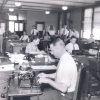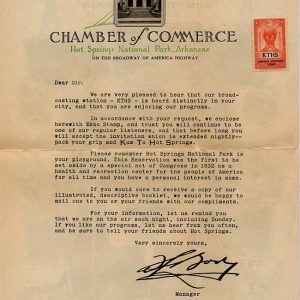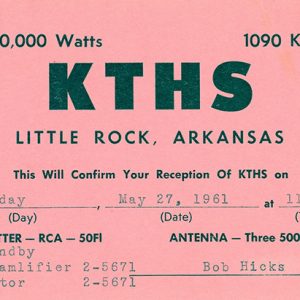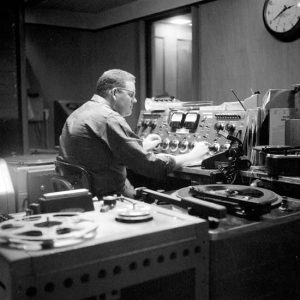calsfoundation@cals.org
KTHS
KTHS, which became KAAY in 1962, is thought to be Arkansas’s third-oldest continuously licensed broadcast radio station. The station survived the turbulent years of broadcasting’s infancy, government regulations, and changes in location and frequencies to become Arkansas’s first 50,000-watt clear-channel station. KTHS was also known for its role in launching the career of the comedy team Lum and Abner.
Radio station KTHS was built in 1924 on the upper floor of the new Arlington Hotel in Hot Springs (Garland County). Facilities included studios and ballrooms wired for broadcast. Two steel towers were installed on the roof between the hotel building’s towers, one 150 feet tall, the other 125 feet, to support the transmitting antenna.
Test broadcasts began on December 11, 1924, prior to the station being licensed. The station was assigned 375 meters, or 800 kilohertz on the AM broadcast dial, with 500 watts of power. At this time, the transmitter was a new Western Electric unit, installed in the “operating room” on the twelfth floor. Studios were built into the west tower of the hotel building.
On December 19, 1924, the Arlington Hotel was issued the authority to operate a Class B broadcast station by the Radio Division of the Bureau of Navigation, Department of Commerce. The assigned call letters were KTHS, which stood for “Kome (come) To Hot Springs.” The founding director was Campbell Arnoux, whose tenure lasted until 1934. KTHS began broadcasting on December 20, 1924, at 8:30 p.m., with an inaugural program originating from the ballroom. On January 1, 1925, the Arlington opened for hotel guests. KTHS programs consisted mainly of live big band music from the ballrooms.
As was the custom in the early days of broadcasting, many stations had to share broadcast time as well as frequencies; on April 8, 1925, KTHS shared 800 kilohertz (then known as kilocycles) with radio station KFRU in Bristow, Oklahoma. KTHS was shut down for maintenance for about a month in the summer of 1926. On June 15, 1927, the station was given an increased power level and a new frequency of 780 kilohertz. On April 1, 1928, KTHS was again reassigned to a new frequency, 600 kilohertz, and granted another power increase to 1,000 watts; at the same time, KTHS shared the frequency with WBAP in Fort Worth, Texas.
In August 1928, the Arlington Hotel presented KTHS to the Hot Springs Chamber of Commerce as a gift; the station was shut down during the week of August 13 to move the station’s facilities to the Chamber of Commerce building at 135 Benton Street. The station’s transmitter facility was moved adjacent to the Hot Springs Golf Club on Malvern Road, and a new 5,000-watt transmitter was installed. KTHS became a commercial radio station in September 1928. On November 11, 1928, KTHS was assigned 800 kilohertz full time, and its power was raised to 5,000 watts. In March 1929, KTHS joined the National Broadcasting Company (NBC) and, in June, was assigned to 1040 kilohertz; power was raised to 10,000 watts.
In April 1931, the comedy duo of Lum and Abner were invited to perform on KTHS for a flood relief benefit; this performance launched their long careers.
By mid-1938, KTHS started its broadcast day at 6:00 a.m. and ended it at 9:00 p.m., sharing its nighttime hours with WBAL of Baltimore, Maryland, on 1060 kilohertz. At this time, KTHS joined the Mutual Broadcasting Network, but this programming was dropped in 1939. By 1941, during Hub Jackson’s tenure as general manager, the station’s frequency was changed to the current 1090 kilohertz; daytime power level was 10,000 watts, with nighttime power reduced to 5,000 watts, allowing simultaneous operation between KTHS and WBAL.
Radio Broadcasting, Inc., acquired KTHS in 1942 and its president, John C. McCormack, named Kenneth K. Kellum the new general manager. In 1945, KTHS was traded to the Shreveport (Louisiana) Times newspaper, and Kellum was replaced by J. John Wolever; the original principals of KTHS concurrently gained possession of Shreveport’s KTBS (no money was exchanged). By June 30, 1943, NBC’s Blue Network, with which KTHS was affiliated, changed its name to the American Broadcasting Company. KTHS’s principals then applied for a license for 550 kilohertz, an upgrade to 50,000 watts, and a move to West Memphis (Crittenden County), but the Federal Communications Commission (FCC) never acted on this request; the same request in 1950 was denied.
In late 1951, KTHS was granted a move from Hot Springs to Little Rock (Pulaski County). The old transmitter on Malvern Highway in Hot Springs was abandoned, and KTHS came on the air with a new transmitter at the present location in Wrightsville (Pulaski County). On August 1, 1962, KTHS was acquired by KAAY, Inc., a new subsidiary of LIN Broadcasting. The FCC approved the sale, the station being sold for $500,000 plus $79,000 covenant not to compete, on July 25, 1962. On September 3, 1962, KTHS became KAAY, with Tom Bishop named general manager.
The call letters KTHS were later recycled for a station based in Berryville (Carroll County). It is owned by Carroll County Broadcasting as of 2013.
For additional information:
“Nashville Firm to Buy KTHS for $620,000.” Arkansas Gazette. May 25, 1962, p. 1B.
Poindexter, Ray. Arkansas Airwaves. North Little Rock, AR: 1974.
“Reaching 1/10th of a Mile into the Air to Reach Many People.” Arkansas Democrat Sunday Magazine. March 29, 1953, pp. 1–2.
Melvin “Bud” Stacey
Satsuma, Alabama
 Mass Media
Mass Media KTHS Building
KTHS Building  KTHS EKKO Stamp
KTHS EKKO Stamp  KTHS Ad
KTHS Ad  KTHS QSL Card
KTHS QSL Card  KTHS Control Room
KTHS Control Room  Little Rock; 1956
Little Rock; 1956 




My father, Jon A. Holiday, was an announcer at KTHS in the early 1950s. I am looking for any articles, pictures, and tape of when he was on the air.
I also have a video that was taken when family visited KTHS and there are several people in the video that look like they worked at the radio station and TV station that I would like to see if anyone can identify. Any information would be appreciated.
[Editor’s note: Email the CALS EOA at awelky@cals.org and we’ll pass on the message.]
In reference to the DJ named “Gatemouth” who was on KTHS. His real name was Frank Page. Page was a legendary DJ on KWKH in Shreveport, Louisiana, and was an announcer on The Louisiana Hayride. Page was the first person to introduce Elvis to a national audience on The Hayride. Frank Page held just about every position you can at a radio station during his time at KWKH. His “Gatemouth” character was one he used in both Hot Springs and Shreveport. I had the pleasure to work with him in the final years of his life at KWKH. He was an incredible person.
I have a letter written to KTHS, New Arlington Hotel, Hot Springs, in December 1925 saying the writer had just listened to the station and how much he enjoyed listening to my dad, Lawson Reid, playing the organ from the Princess Theatre in Hot Springs. Apparently it was a late-night program on the station.
The writer was in West Palm Beach, Florida, and listened on an 8-tube Supertone radio; the program came in clear as a bell.
I’m seeking a tape or copy of that program. I’d love to get a copy of my dad playing a big theatre organ. He played at theatres in Little Rock, Rockford, IL, Chicago, St. Louis, Tulsa, etc., before heading for New York, Pennsylvania, etc., playing the big Wurlitzers for silent movies.
I thought it might interest you to know that back in the early 1950s, KTHS at 1090 Khz was easily heard during the winter months in Winnipeg, Manitoba, Canada. I can’t exactly remember the correct time, but there was an evening program from about 9:00 p.m. to 11:00 p.m., with a DJ called Gatemouth. It was a real treat for us listeners here because there was no real access to R&B or blues in this area. Thanks to KTHS, I grew up listening to the likes of Howlin’ Wolf, Muddy Waters, Lightnin’ Hopkins, Jimmy Reed, and many others. I was around fourteen years old at the time, and it inspired me to get a guitar and learn the songs I heard. I’ve been doing it ever since. As I recall, we could get a selection of six 45 rpm records mailed to us for about $2.99. KTHS was a tremendous influence in spreading awareness of some of music’s greatest artists.
My father was the managing partner of the group that owned KTCN in Berryville, Arkansas, in the early 1960s. He subsequently bought the rights to the KTHS call letters when they became available and moved them to Berryville, substituting them for KTCN.